 |
|||||||||
Music Webmaster
Len Mullenger:
Len@musicweb-international.com
|
Classical Editor: Rob
Barnett
Music Webmaster |
||||||||||||||||||||||||||||||||||||||||||||
Alexandra Hawley (flute) Jean-Pierre Rampal (flute) Stanford Woodwind Quintet
rec 21-26 Jan 1995 and 26 Feb 1996 San Rafael, California NAXOS AMERICAN CLASSICS 8.559001 [6841]
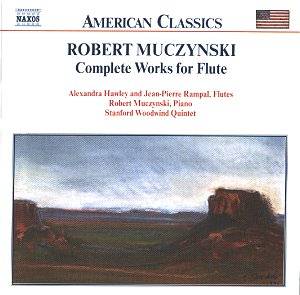
Wind Quintet (198.5)
Duos for Flutes (1973)
Moments for flute and piano (1992)
Fragments for woodwind trio (1958)
Three Preludes for unaccompanied flute (1962)
Movements for wind quintet (1962)
Duos for flute and clarinet (1984)
Flute Sonata (1961)
I was not predisposed to enjoying this music but was surprised when I played the disc.
The Quintet is succinctly succulent with on-your-toes dynamism, a heart-beat slowing andantino and some blissfully elysian birdsong. The central andantino reminded me of Vaughan Williams Vocalises for soprano and clarinet (1958).
Rampal joined Alexandra (not Alexander as the booklet dubs her!) Hawley in the Duos for two flutes in performances of abundant charm (the two instruments echoing off each other in the allegro risoluto). The opportunity to hear the same music in different garb comes in tracks 26-31 where flute and clarinet are the executant instruments.
The Moments migrate from Waltonian arabesque (Walton V at the start of the score) to a Poulencian andante that is not without urgency. Muczynski is the pianist. The Fragments evoke summer dreams in Reverie and adopt a cheeky though tasteful exuberance. The Three Preludes include a sea chanty style movement similar to Malcolm Arnold's Chanties. The Movements for wind quintet have a Moeran-like resolve. The Sonata has a greater angularity than the other works which makes it impressive as display but not winning musically speaking.
Detailed informative notes by the Ledins.
Reviewer
Rob Barnett

James Buswell (violin) National SO of the Ukraine/Theodore Kuchar
rec 27-31 May 1998, Kiev NAXOS AMERICAN CLASSICS 8.559003 [60.49]
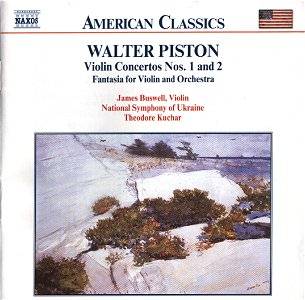
Walter Piston, quite unjustifiably, has a reputation for dryness and academicism. He shares this reputation with Peter Mennin and it casts a quite unjustified slur on his romantically-inclined music. In the two concertos on this disc Piston's standing as an accessible and enduringly sinewy romantic is well and truly affirmed.
The first concerto was written for Ruth Poselt who premiered the work in 1940. It has been recorded before (though not on CD) by Hugo Kolberg with the Berlin SO conducted by Otto Mazerath (Mace LP MXX9089).
The concerto is absolutely splendid - modelled on the Tchaikovsky but having more than a few reference points with the Walton and the Barber. Michael Tippett's ecstatic string hymns from Concert for Double String Orchestra also seem to have touched this music which rises to a fine ecstasy at 5.03 in the first movement. This work has the sheer punch of the same composer's second symphony (try the Tilson Thomas/Boston recording for best effect) and the hurtling finale effervesces, darts and skims in circus stamping bravado.
The 15 minute Fantasia is a late work - drier, dissonant and challenging though not without a certain hard-won rhapsodic Bergian lyricism.
Less challenging is the 1960 second violin concerto (written as a Ford foundation commission for Joseph Fuchs) - rather like a time-filtered version of the Barber violin concerto. Melody is still important but it is tough although well worth the struggle. The second movement is a lean adagio - a reflective, sustained and whisper-quiet prayer. The finale flings notes around the aural landscape, flashes, flickers and hammers with compulsive energy.
Buswell (last heard as soloist in Previn's recording of the Vaughan Williams violin concerto on RCA in the late 60s) is superb and characterful throughout. Not a hint of the '3-piece suit commission' about this performance or any of this music.
A great disc of rare music and at any price unmissable but this is at bargain price! Excellent recording quality, by the way, and the usual good background notes by the Ledins and a more personal contribution by the soloist.
Reviewer
Rob Barnett

*Janacek PO/Joel Eric Suben Slovak RSO/ Joel Eric Suben
rec 1995 and 1996 in Slovakia and the Czech Republic NAXOS AMERICAN CLASSICS 8.559012 [75.08]
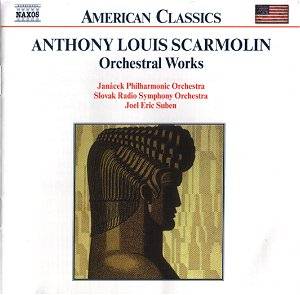
The Caliph - Dance (1948) *
Three Miniatures (1920) *
Three Preludes (1995)
The Sunlit Pool (1951)
Invocation (1947)
Variations on a Folk Song (1953)
Arioso for strings (1953)
Concert Piece for trumpet and strings (1962)
Prelude (1964) *
Scarmolin was Italian-born but came with his family to New Jersey when he was 10. Early infatuation with atonalism was soon abandoned and he returned to composition in a richly tonal idiom. There are some 1100 compositions and a Scarmolin Trust who, I hope, will go on to support recordings of his other works including the symphonies.
The Dance from The Caliph is a typical Nautch Girl dance - swaying and winding seductively in Arabian pirouette and with a lightly convulsive Hispanic snap (yes, complete with castanets). Over it all hangs a Verdian operatic cloak.
The Three Miniatures are lightly handled in the manner of Alfven's Midsommarvarka and Shepherd Fennel's Dance (Balfour Gardiner)
The Preludes (orch by John Sichel): Night at Sea bursts into flowering filmic lyricism in a way suggestive of Frank Bridge's Summer, The Story of My Heart or Enter Spring and the magnificent sea music of Philip Sainton (Moby Dick): salty memories indeed of marine glory and sun-dappled waves. Snowdrift is tentative and lightly impressionistic. White Meadows dates from 1954 unlike the other two preludes and rates high on aestival lyricism.
The Sunlit Pool floats in warm melody with again a touch of the sunnier Bridge and of Bax in Happy Forest and Spring Fire. It also reminded me of another composer whose music I have encountered recently: Alfred Hill. Hill's multitude of short orchestral poems are often in a similar impressionistic vein.
Invocation announces itself as a more serious piece with ambitious emotional span and Debussian aspirations. Its opening bars, which rear up several times, have a Brahmsian weight and storminess and a Rózsa-like exaltation.
The Folk Song Variations are for strings and take as their subject a Piedmontese song of simple pleasures played with a hint of Palm Court schmaltz. Also for strings the Arioso resounds in Elgarian eloquence similar to the Serenade.
The trumpet Concert Piece is cheekily perky and winningly positive even in repose; not at all the sacerdotal role cherished by Alan Hovhaness in his similar pieces.
Prelude shares some of the atmosphere of The Sunlit Pool and, pace the notes, seems written in the same warm drifting fragrance which awakes close to Tchaikovsky's Romeo and Juliet and at other times near Delius's smaller tone poems. A more colourful title perhaps exists in Scarmolin's archives.
The Czech musicians seem to handle this unfamiliar material well although once or twice I wondered if a more vibrant pulse might have helped the music along.
Intrinsically this is attractive music of a largely light character.
The notes, by John Sichel, are helpful in providing the orientation we need with this unfamiliar music: attractive - definitely - but not arresting. I certainly would like to hear more. If you have enjoyed the British light music series then you will want this and are unlikely to be disappointed.
Reviewer
Rob Barnett

NOTE TO NAXOS: I do hope that the series advisers will consider a recording of the music of Leroy Robertson. His violin concerto is a work of a Hansonian caste and virtuosity - an easy winner.
Kenneth Boulton (piano)
rec 1995-1997 NAXOS AMERICAN CLASSICS 8.559020 [73.51]
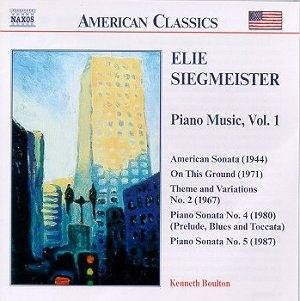
American Sonata (1944)
On This Ground (1971)
Theme and Variations No. 2 (1971)
Piano Sonata No. 4 (1980)
Piano Sonata No. 5 (1987)
Elie Siegmeister was a New Yorker whose name is probably known (if at all) to most listeners for his two orchestral suites: Ozark Set (1943) and Western Suite (1945). I have heard tapes of his symphonies 3, 4 (premiered by Maazel) and 6 and the violin concerto; the latter pioneered by Cho Liang Lin and many of these are in an argumentative avant-garde style.
Siegmeister's musical style is often dyspeptic and challenging. The most immediately approachable piece on the CD is the American Sonata with its explosively tumbling jazziness gambolling through territory to which Lambert, Walton and Gershwin had already laid claim. There is also a totally charming touch of Arthur Benjamin's Jamaican Rumba. The second movement is plangently melancholy with more than a suggestion of Peter Warlock and William Walton (middle movement of his under-estimated Sinfonia Concertante). The joyous and ripely syncopated finale is decidedly Stravinskian (Petrushka-era). A sweet Mediterranean semplice (2:12) relieves the headlong rush. The sonata is not especially American to my ears. It is however extremely attractive and well worth hearing.
The remainder of the works on this well-filled disc are challengingly atonal. On This Ground has the piano protagonist wandering under lichen-strung forest boughs amidst mild discords, battering cascades of notes (Ariel) and clammy caves explored during a dank summer. Mr Henry's Monday Night alternates a rip-roaring sprint with slower sections.
Theme and Variations inhabits a tough school and it is one which, to my ears, yields very sparse rewards. The 4th sonata has a Petrushkan prelude, a bluesy andante with a Celtic lilt and, to round off, a poundingly chaotic allegro vivace. The fifth sonata's first movement suggests very slow singing with the notes softened and diffused atonally. The anarchically hammered finale reeks of the 1920s but this fast-driven storm is contrasted with a slow dreamy bridge passage.
The insert is good although the central two pages were left blank in my copy and I would guess that this will be put right in future printings.
This Naxos series continues to spill out bountifully every month. It promises to be THE series of US classical music. When New World and Delos ran out of stamina Naxos slipped naturally into the scene and are doing a job of historical value. If that was all it might seem rather an ascetic exercise. In fact it has already yielded some wondrous treasures, much enjoyment and discovery after discovery.
My star marking reflects my reaction to all but the American Sonata. The performances are, as far as I can tell, excellent as also is the recording
Reviewer
Rob Barnett

Kenneth Boulton (piano)
rec Philadelphia 1995-1997 NAXOS AMERICAN CLASSICS 8.559021 [71.47]
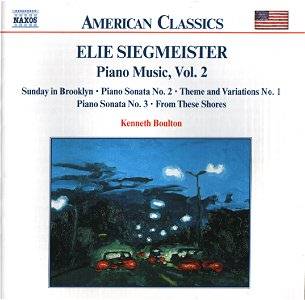
Sunday in Brooklyn (1946)
Piano Sonata No. 2 (1964)
Theme and Variations No. 1 (1932)
Piano Sonata No. 3 (1979)
From These Shores (198.5)
This is to much the same recipe as Vol. 1: One work (the first on the disc) approachable and having instant attractions; the rest is gently atonal but clearly the product of an avant-gardiste. It is no surprise to hear that, after his four years in Paris studying with Nadia Boulanger, he returned to the USA and found an affinity with Henry Cowell and Marc Blitzstein. His natural voice is as a pioneer pushing at and breaching the boundaries of tonality.
Sunday in Brooklyn represents the approachable voice. It has plenty in common with the American Sonata of two years previously. In Prospect Park Billy Mayerl meets Delius meets Gershwin. Here you can fully appreciate Boulton's deliciously relished light touch. This suite also accentuates the scatty and mixes it with the grand promenade and quite a few splashes of John Ireland (Amberley Wild Brooks). Siegmeister, the flaneur, predicts the main theme from Star Wars in Sunday Driver. The Family At Home drips slow-motion honey followed by the sentimentality of Children's Story. Coney Island rips and snorts along in Stravinskian railroad rhythms.
The second and third piano sonatas provide flanking for the Theme and Variations. The latter has already established (in the early thirties) the composer's voice as one that crosses the line of tonality and does so with abandon and hints of Caledonian highland dances. The single movement Second Sonata's shrapnel fragments of Beethoven 5 contrast with the three movement Third Sonata with its demented Schoenbergian dream - all broken mirrors and Ravelian impressionism.
The final five movement suite is a very late work. It has nothing in common with the Brooklyn piece. Whitman, Faulkner and Twain are among those 'pictured within'. The Twain movement is gawkily grotesque. The Thoreau sketch finds some easeful repose in holding an atonal mirror up to Macdowell's flower pieces and the woodland's noble savagery. The Langston Hughes movement is a restless portrait suggestive of Harlem while the final Faulkner essay skips and calls like an anteater on white hot coals.
Kenneth Boulton who also wrote the astute notes provides all the unruly liveliness and anarchic impressionism your heart could crave.
I find myself out of sympathy with most of this music apart from the Brooklyn suite. My star marking reflects my reaction accordingly. to all but the Brooklyn piece.
Reviewer
Rob Barnett

Rasumovsky Orchestra/Keith Brion
rec Bratislava 1995 NAXOS AMERICAN CLASSICS 8.559008 [60.42]
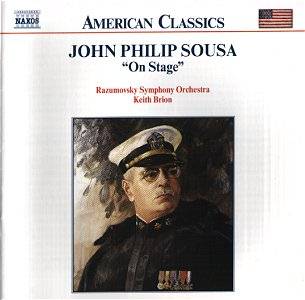
This disc aurally portrays one facet of Sousa's talent. He was active in the field of musicals. Three of them are quarried here for orchestral tid-bits.
The Bride Elect (1897) is evocative of Rheinland ebb and flow with a dash or two of Alt Wien Neujahres charm thrown in for good measure. There is an absurd tarantella followed by a series of alcoholic musical 'swigs'. The Champagne movement features popped corks (an obviously Straussian touch). Rhine Wine is a Delibes-like delight. The harp arpeggiated White Rock and Psyche is followed by men's stuff in Whiskies. Cordials resounds with confident silliness and all ends with (what else but) a jolly march.
El Capitan (1895) is again a Straussian effort. Its movements include a yearningly eloquent O Warrior Grim with its trumpet solo for trumpet and a fluttering confection in waltz-time. The whole is rounded out with the famous march with its whooping French horns. Our Flirtations (1880) has an overture with flashy and sentimental solos for flute and trumpet finishing with a quick-time march - all white epaulettes, sabre-taches and chromium swagger.
You will know if you like this. It seems (rather like the Sousa at the Symphony disc) to be very well done and most agreeably documented and recorded.
Reviewer
Rob Barnett

Rasumovsky Orchestra/Keith Brion
rec Bratislava 1996 NAXOS AMERICAN CLASSICS 8.559013 [62.12]
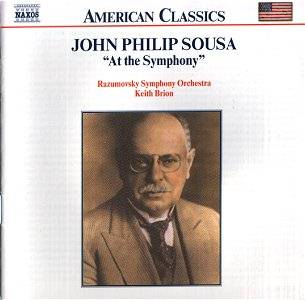
Sousa's fame as a 'march merchant' is secure. That fame is part reflected in the present collection. In addition we are reminded of his work in other concert-hall spheres.
Many of his marches now have a rather absurd air hanging about them. The Irish Dragoons (1915) contrives to be simultaneously dashing and loopy. Bullets and Bayonets (1918) is a pugnacious skirlinskirling effort peppered with gunshots and echoing with the fife and drum - all rather incongruous in the face of the contemporaneous slaughter on the fields of France. That incongruity seems to be objectionable only now. Perhaps, at the time, contemporary sensibility had no difficulty squaring tragedy and escapist absurdity.
Jack Tar (1903) reeks of a sea-green queazy absurdity. Power and Glory is a pompous stamping affair. Invincible Eagle (1901) and Semper Fidelis (1888) are part of Sousa's formula for fame; a recipe rounded out by Stars and Stripes with its hallmark horns crying out over the symmetry of the music. Those billowing horns seem to be tracing the contours of far horizons. The lesser-known quick-time march Daughters of Texas is the usual potage of silliness and pomp.
The marches can be contrasted with a series of genre pieces and suites paralleling the work of the hundreds of light music purveyors active in England and documented through Phil Scowcroft's series of Garlands. Nymphaline Reverie (1880) is a Gallic-style balletic delight. Profane pleasures are put away in Grace and Songs of Glory - A Sacred Selection (1892). In this Sousa adroitly apes the required sanctimonious manner. The Suite: Dwellers of the Western World portrays the three American races: The Red Man comes to us courtesy of Smetana's Vltava!, while The White Man takes us to Dvorák's New World. The final movement, The Black Man has just enough of the flashing white teeth and street-corner tap dancing to make you shift uneasily in your seat. However, for its time, the portrayal was no doubt acceptable. The silvery and glinting Humoresque is based on Gershwin's song Swannee.
The disc is well documented. The arrangements are by the conductor who has made a speciality (or should I say specialty) of this repertoire. There is much that is undemandingly enjoyable here. It will appeal to all lovers of light music though I cannot pretend that, as music, it is especially distinguished.
Reviewer
Rob Barnett

David Craighead (organ) David Mulbury (organ) The Fairfield Orchestra/John Welsh
rec New York City May 1994 NAXOS AMERICAN CLASSICS 8.559028 [70.29]
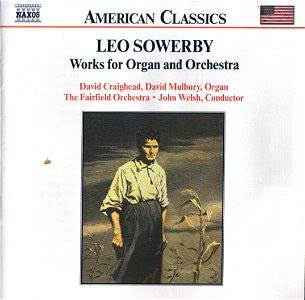
Classic Concerto (1944)
Medieval Poem (1926)
Pageant (1931)
Festival Musick (1953)
Sowerby's most famous (or perhaps, more accurately, least obscure) composition is the overture Come Autumn Time which Solti conducted with the Chicago SO during the 1980s. Before that the music had dropped from orchestral programmes for many years and still struggles to make headway even in these times of more catholic tastes in which people are recapturing the romance of the first half of the century.
Sowerby, born in Grand Rapids, Michigan, became a devotee of the organ and many of his compositions are for that instrument. The Classical Concerto is in three movements: snappy, dreamy and in the finale echoing the string writing of Vaughan Williams (Partita and Concerto Grosso). The Medieval Poem is in a more challenging language with suggestions of Hovhaness (the wandering trumpet tune at 1.55) and Delius (his Dance Rhapsodies). This Delian impressionism is intensified by the solo voice of soprano Rita Lilly. The 1931 Pageant I found predominantly rather drab but the three movement Festival Musick is a different proposition with its clashing harmonies, Waltonian brass, and quiet chorales. Unfortunately my copy of the disc must have been defective as the music disappeared in the middle of the last movement (track 8). Approach with caution. My copy may have been an isolated blip but in the circumstances I must give a low star rating despite a disc that was largely of most promising calibre.
Reviewer
Rob Barnett
(due defective part-missing track)
Moscow SO/Adriano
rec March 1998, Moscow NAXOS 8.559018 [66.35]
Save around 22% with
Crotchet
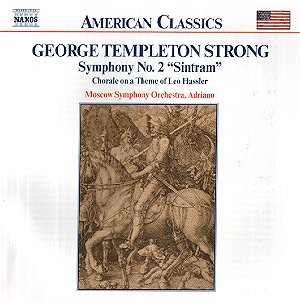
Strong's is an unfamiliar name to all but the most determined and all-inclusive of collectors. The aficionado will know the name and indeed this symphony from the Karl Krueger SPAMH LP. This may, I suppose, be reissued by Bridge in due course but for now the present CD is the only game in town.
Strong's 'high noon' romantic Sintram symphony raises expectations in its scale (almost an hour) and in its subtitle - 'The Struggle of Mankind Against the Powers of Evil'. These ambitious goals are reflected in the first movement in monastic contemplation and some passionate climaxes. Despite the tunes being nowhere near as memorable the movement has parallels with Tchaikovsky's Romeo and Juliet. Some of the horn calls are Brucknerian. The Langsam (II) has elements of Brucknerian languor but gives the impression of being on nodding acquaintance with the world of potted palms and grand marble hotel vestibules. The third movement is back to grand themes - and gloomy ones - 'The Three Terrible Companions: Death, the Devil and Insanity'. Brucknerian upsurges lead us into some positively Lisztian (or Saint-Saens) demonic stuff - witchery and covens. The 'Victorious Struggle' of the finale speaks in a language we know from Tchaikovsky's Hamlet and Tempest and from Liszt's Hunnenschlacht. The performance sometimes seems lumbering although that impression does not hang over the adagio or the finale. The musical ideas are nowhere near as memorable as Tchaikovsky's mainstream successes but anyone who likes the more obscure tone poems of Tchaikovsky and Liszt will enjoy this.
The Hassler Chorale is a short work from nearly 40 years after the symphony. It richly deserves to be programmed as an alternative to the Barber Adagio. Its funereal pace does not close the door on considerable beauty. It also reminded me a little of Josef Suk's Wenceslas Chorale.
All in all an attractive CD (good notes by the Ledins) whose low key beauties are not to be looked down on. I note that this is the first instalment in a complete series of Strong's orchestral works. I await later instalments with the keenest curiosity.
Reviewer
Rob Barnett

MEREDITH WILLSON (1902-1984) Symphony No. 1 in F minor A Symphony of San Francisco (1936) 39 mins Symphony No. 2 in E minor The Missions of California (1939) 31 mins Moscow SO/William T. Stromberg
rec Moscow, June 1998 NAXOS 8.559006 [70:38]
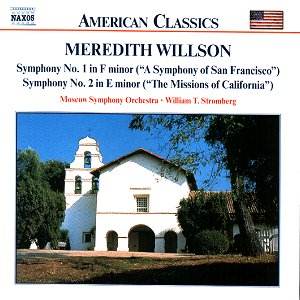
Meredith Willson's symphonies are relaxed documents of entertainment rather than barn-storming epics. They are given cheerfully enthusiastic performances by the adventurous Stromberg and the intrepid Muscovites.
Willson may well be better known to you as the composer of two successful musicals: The Unsinkable Molly Brown (Titanic again!) and The Music Man. He wrote music for Hollywood films and orchestrated Chaplin's score for The Great Dictator. A man of many careers his music is not to be dismissed and Naxos have done us great service in making this recording.
The first symphony's first and fourth movements refer to one of those themes that suggest Medieval pageantry and derring-do - a refugee from the (in fact) much later Rózsa score for Ben-Hur. It bursts with influences, all of a conservative cast. Ultimately it feels somewhat ramshackle as a work but has its moments and one can imagine becoming quite affectionate towards the piece.
The second symphony is from three or so years later. The voices are Russian (Rimsky is not far away) all those woodwind rhapsodies and curlicues! There is more than a trace element of Biblical epic and I suspect Willson had heard Howard Hanson's Nordic Symphony. The Straussian (Richard) violin solos and babbling Respighianisms all make for a fun symphony and considerable pleasure provided your sights are not set too high. Each of the movements has one of the Californian missions as its subject - a little like Respighi's Church Windows and Gesensway's Squares of Philadelphia. The andante is a deeper movement of patent sincerity. The Capistrano movement (III) has the swallows darting and diving across the wide sky in attractive woodwind display. The final El Camino Real (Royal Road) is catchy and nervy with railroad rhythms and grand with Hollywood romance (5:01 - Rachmaninovian grandeur) before the idiom had really established itself. I felt that in this work the playing really caught fire.
Two estimable symphonies that will deliver plenty of entertainment without plumbing depths or ascending the heights.
Reviewer
Rob Barnett

Yet to come … not released as yet …. CRESTON Symphonies 1-3; RANDALL THOMSON Choral works; BARBER Symphonies 1-2; VIRGIL THOMSON Symphonies 1 and 3 and no doubt more ……. All to be reviewed on this site.
Return to [Part 1] [Part 2] [American Naxos part 1] [January Index]
Search the Crotchet database from here
Discs on these pages are offered for sale. There is also a page of search engines from a selection of on-line retailers here.
Please support this web-site by buying your discs here.
Disclaimer: Every effort is made to make sales links to the correct disc but, in the end, you must take responsibility for checking that what you are purchasing is what you want. Some of these discs were not actually available for sale at the time of posting but a link has been made in anticipation of their forthcoming availablility.Any opinions expressed in reviews or articles on this site are those of the author and do not necessarily represent the views of the site owner, Len Mullenger or the Editors. Reviewers and authors retain copyright in their work unless it has been paid for or commissioned by the site owner.
All prices, special offers etc relate to the month of publication only or as stated.
Return to Index of Classical Reviews